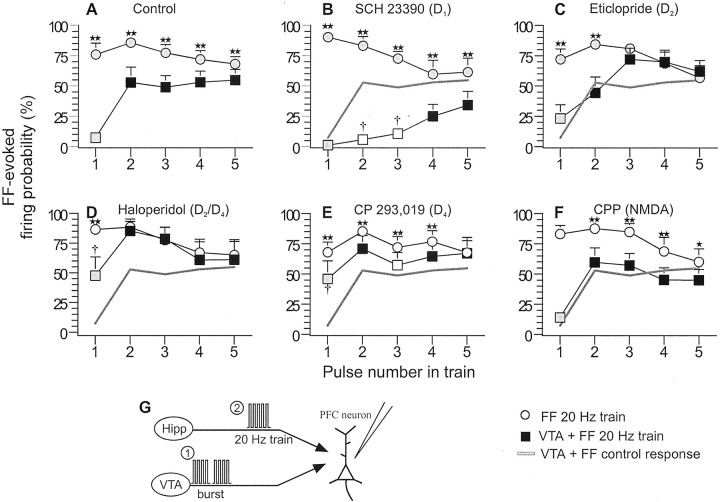Fig. 6.
The effects of D1, D2, D4, and NMDA receptor blockaded on VTA-induced inhibition of FF-evoked firing in PFC neurons. For all panels, symbols represent mean (+SEM) firing probability evoked by each pulse in a five-pulse train delivered to the FF. Gray circles represent FF-evoked firing probability for each pulse in the five-pulse train, when no VTA stimulation was given. Squares represent FF-evoked firing probability after a VTA burst. Black squares denote significant within-group difference (p < 0.05), and white squares denote no significant within-group difference in firing probability observed for latter pulses in the train compared with the firing probability observed during the first pulse (gray square). For comparative purposes, the gray line inB–F represents firing probability of the control condition (VTA + FF). *p < 0.05, **p < 0.01, significant difference versus probabilities within groups, observed at the same time point in the train with and without VTA stimulation;†p < 0.05, significant difference in firing probabilities between groups versus those observed at the same time point in the control condition (gray line). A, Burst stimulation of the VTA dramatically reduced firing evoked by the first pulse in the train but was less effective for pulses 2–5.B, Administration of the D1 antagonist SCH23390 augmented the VTA-induced inhibition. C, The D2 antagonist eticlopride abolished the inhibition of firing observed in the latter parts of the train, whereas haloperidol (D) almost completely attenuated the inhibition. The D4 antagonist CP 293,019 (E) also attenuated the inhibitory effect of VTA stimulation. The NMDA receptor antagonist CPP (F) was without effect.G, Diagrams of the stimulation protocol used in this experiment. Here, the VTA was stimulated in a burst pattern (1) before five-pulse, 20 Hz train stimulation of the FF (2).

